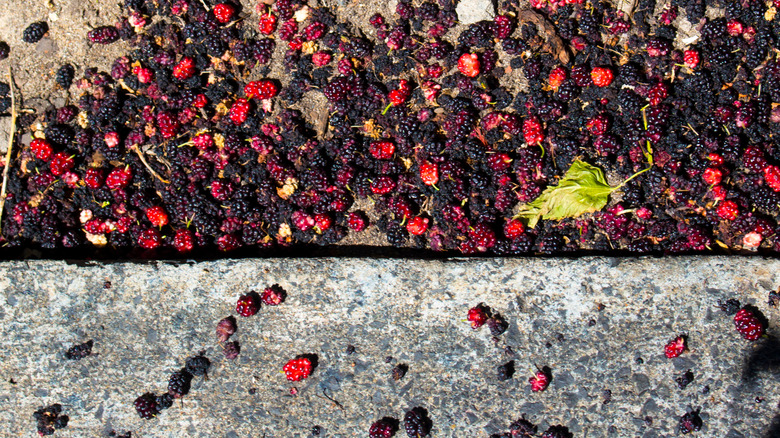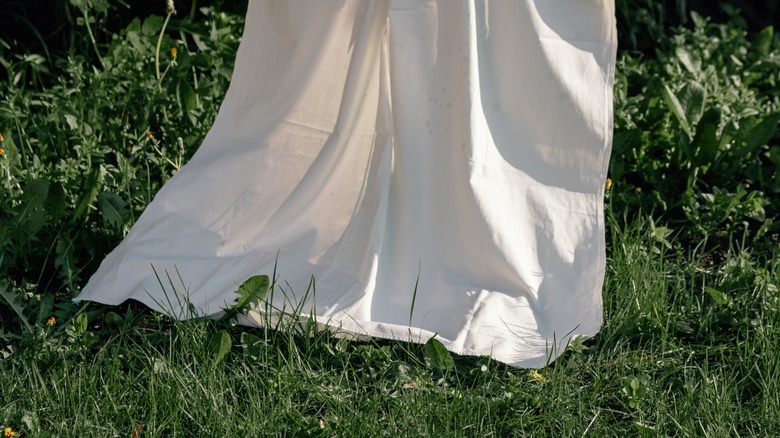Repurpose Bed Linens To Keep Berry Shrubs From Making A Mess On Your Sidewalk
We may receive a commission on purchases made from links.
Having berry-producing bushes perfect for your yard is pretty neat. You can add them to smoothies, make jars of tasty jam, or provide a source of high-calorie food to visiting wildlife. Whatever the reason for growing berry bushes, there's a distinct downside to those that overhang sidewalks, garden paths, and driveways: wine-red stains that are tricky to remove without the aid of lots of scrubbing, cleaning products, or time to fade. Thankfully, protecting your paving before it gets to that stage is easy and cheap, and in many cases, doesn't even involve opening your wallet. Head to your linen closet, grab those retired bedsheets you've been saving for, well, some useful purpose (that time has come!), and lay them on the ground under the fruit-laden branches to collect berries as they fall.
For the most part, berries — but especially mulberries — fall off their parent shrub when they're ripe. This is handy for gardeners since it's easy to tell when berries are ready to eat. It's not so helpful if you're not around to harvest said ripe berries. They're soft when ripe, so if they fall on a hard surface, like, say, your patio pavers, they squish and stain. Thanks, gravity! That's where this bedsheet method comes in. Note that if your berries are falling and aren't ripe, you have a different problem on your hands: lack of pollination, disease, under or over watering, or a myriad of other concerns.
How to collect berries with a bed sheet
Lay a bedsheet on the ground below your mulberry tree or the delicious varieties of blueberries that thrive in your garden in the early morning. It will passively collect the ripe fruit as it falls. In the late evening, bundle up the berry-filled sheets and bring them inside. You could also tie the sheets to the lowest branches or to four posts hammered into the ground, making a hammock. This reduces sidewalk staining and gives the fragile falling fruit a soft landing. Alternatively, recruit some friends or family members to help you hold the corners of said bedsheet and use a broom, rake, mop, or any other stick-like implement (or just your hands) to shake the berries out of the tree. As with the passive method outlined above, the sheet doubles as a berry basket.
If you're expecting rain or typically experience dewy mornings, don't leave the sheet out overnight. A soggy sheet will cause any berries that fall on it to rot before you can get to them. Instead, collect the berries before evening and take the sheet in, then lay it out again the next morning, collecting any berries that have fallen on the sidewalk overnight before you do so. Make sure you don't let the berries sit for too long on the sheet. They may get eaten by opportunistic animals, or their juice could soak through the sheet, defeating the purpose of putting the sheet down in the first place.
Sourcing a cotton bed sheet for free or cheap is key
If you want to take advantage of one of the best ways to repurpose old bedsheets but don't already have said sheets, there are other ways to get some. Ask your friends, family, or even neighbors for donations. Post in your local Buy Nothing group — use the finder on the initiative's website to see what's near you. Check Facebook Marketplace for giveaways or cheap deals. If you prefer new sheets, you can pick up budget-quality linens cheaply at thrift stores, or keep a close eye on Amazon or your local big box retailer (looking at you, Walmart) for sales. Seek out pure cotton (or other natural fiber) sheets over synthetic textiles. They're water-permeable and won't shed microplastics all over the place.
Alternatives to bedsheets include tarpaulins or large sheets of cardboard. Neither are ideal, since the former collects water and the latter deteriorates quickly. Fine mesh netting might seem like a good idea. It's durable, and water drains through it. However, birds and other wee beasties like snakes can get entangled in it, and little research has been done to determine a wildlife-safe mesh size. If it's in the budget, you can buy specialized fruit harvesting nets. For example, Amazon sells a 32.8 foot x 16.4 foot Ex4garden fruit and nut collecting netting for around $90. But why bother dropping that much dough when an ordinary bedsheet does the same for less!

